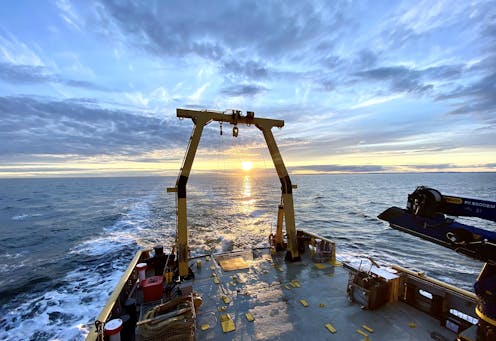
The waters of the St. Lawrence Estuary are running out of breath. The lack of oxygen in deep waters is affecting the organisms that live on the bottom of the estuary.
How do deep ecosystems react to this deoxygenation?
In a previous article, we highlighted the causes of the decrease in the concentration of oxygen in the bottom waters of the estuary and Gulf of St. Lawrence. This phenomenon, called hypoxia, is intensifying in this environment. In this article, we look at the impacts of low oxygen levels on the organisms that live at the bottom of the estuary and the Gulf of St. Lawrence, and on the overall functioning of this ecosystem.

This article is part of our series, The St. Lawrence River: In depth. Don’t miss new articles on this mythical river of remarkable beauty. Our experts look at its fauna, flora and history, and the issues it faces. This series is brought to you by La Conversation.
The seabed, an environment teeming with life
A large number of organisms live at the very bottom of the oceans. These are known as benthic organisms.
This group of small animals includes starfish, worms, crustaceans and molluscs. They colonize the surface of the sediment (known as epifauna; “epi” for “on,” and “fauna” for “animal”) or burrow into the sediment (known as endofauna; “endo” for “inside”).
These organisms are not very mobile and cannot travel great distances.
Bioturbation or the art of mixing sediment
Benthic organisms don’t move around much, but they are far from being useless. On the contrary, they play a crucial role in the functioning of benthic ecosystems, through bioturbation.
Bioturbation refers to all the activities that benthic organisms carry out, both on, and in sediments. Bioturbation can be compared to what earthworms do in our gardens: they dig burrows, mix grains of sediment and inject water containing oxygen into areas of the sediment that lack it.
Benthic organisms are therefore the “gardeners” of the ocean floor. And they help to maintain a healthy ecosystem. By bringing oxygen into the sediments, bioturbation allows many organisms to establish themselves there. It also increases biodiversity and promotes the decomposition of organic matter while reducing the concentration of potentially toxic waste, such as hydrogen sulphide.
Oxygen and bioturbation: a not-so-simple relationship
Twenty years ago, researchers used models to try to predict the consequences of deoxygenation on the ecosystems of the bottom of the St. Lawrence. Their work highlighted a critical element in anticipating future changes: how bioturbation responds to oxygen depletion.
Deoxygenation can lead to several types of responses in ecosystems. In a linear response scenario, the intensity of bioturbation decreases gradually and proportionally with the decrease in oxygen concentration. In such cases, it is relatively simple to predict the consequences, as the relationship is predictable.
However, there is another type of response that is non-linear and characterized by a threshold effect. This means that there is a certain critical point, a threshold, at which responses change abruptly. Before this threshold, the responses differ from those observed afterwards. These non-linear responses are associated with the development of resistance (or compensatory) mechanisms. These mechanisms operate at the level of the individual, the population (the set of individuals of the same species in a given location) and/or the community (the set of populations in a given location). They compensate for the effects of a disturbance until they are no longer sufficient. It is these compensatory mechanisms that make it difficult to predict the consequences of a disturbance.
A non-linear relationship
Our team has been studying the deoxygenation of the St. Lawrence for more than 20 years, but we had never before observed a clear relationship between the bioturbation of communities of benthic organisms and oxygen concentrations.
This raises an important question: does bioturbation respond in a linear or non-linear way to oxygen depletion? And is this a predictable relationship?
The recent fall in oxygen concentrations in the bottom waters of the St. Lawrence has enabled us to answer this question by observing a threshold effect for the first time. We now know that the relationship between oxygen concentration and the functioning of benthic ecosystems is not linear.
In other words, these ecosystems can resist deoxygenation up to a certain critical threshold, which is observed at an oxygen concentration of around 60 micromolar (i.e. approximately 20 per cent saturation, or 20 per cent of what the dissolved oxygen concentration should be if the water were in equilibrium with the atmosphere). This concentration is close to the value above which we speak of hypoxia. Below this threshold, communities of benthic organisms change, but surprisingly, without any significant loss of biodiversity.
However, the organisms that make up these communities are much less active. They are actually running out of air! They considerably reduce their movements, move towards the surface of the sediment and the intensity of bioturbation becomes practically zero.
In other words, in these conditions of severe hypoxia, the organisms no longer have enough energy to mix and irrigate the sediment.
When bioturbation stops, what happens?
These results have major implications for the role of sediments in the overall health of ecosystems in the estuary and Gulf of St. Lawrence. When bioturbation stops, the sediments are neither mixed nor irrigated efficiently, leading to the accumulation of toxic waste very close to the surface of the sediment.
As this waste accumulates, it could even spread into the water column, scaring away sensitive species and increasing deoxygenation.
When and under what conditions would this happen? This is the question we now need to answer.
Deoxygenation of the bottom waters of the St. Lawrence is of particular concern because it is likely to lead to changes in the abundance and distribution of fishery resources. Indirectly, therefore, it could have socio-economic effects that have yet to be fully assessed.
Ludovic Pascal is a member of the Québec Océan inter-institutional group and the Nereis Park scientific association. He has received funding from the FRQNT, the MEOPAR Network of Centres of Excellence, and the Québec government (Réseau Québec Maritime, MEIE, MELCCFP).
Gwénaëlle Chaillou has received funding from the Natural Sciences and Engineering Research Council of Canada (NSERC), Fonds de Recherche du Québec, Canada Research Chairs, and the Government of Québec (Réseau Québec Maritime, MEIE, MELCCFP). She is a member of the Québec Océan inter-institutional group, ACFAS, the Geochemical Society and the International Association of Hydrogeologists - Canadian National Committee (IAH-CNC).
This article was originally published on The Conversation. Read the original article.







